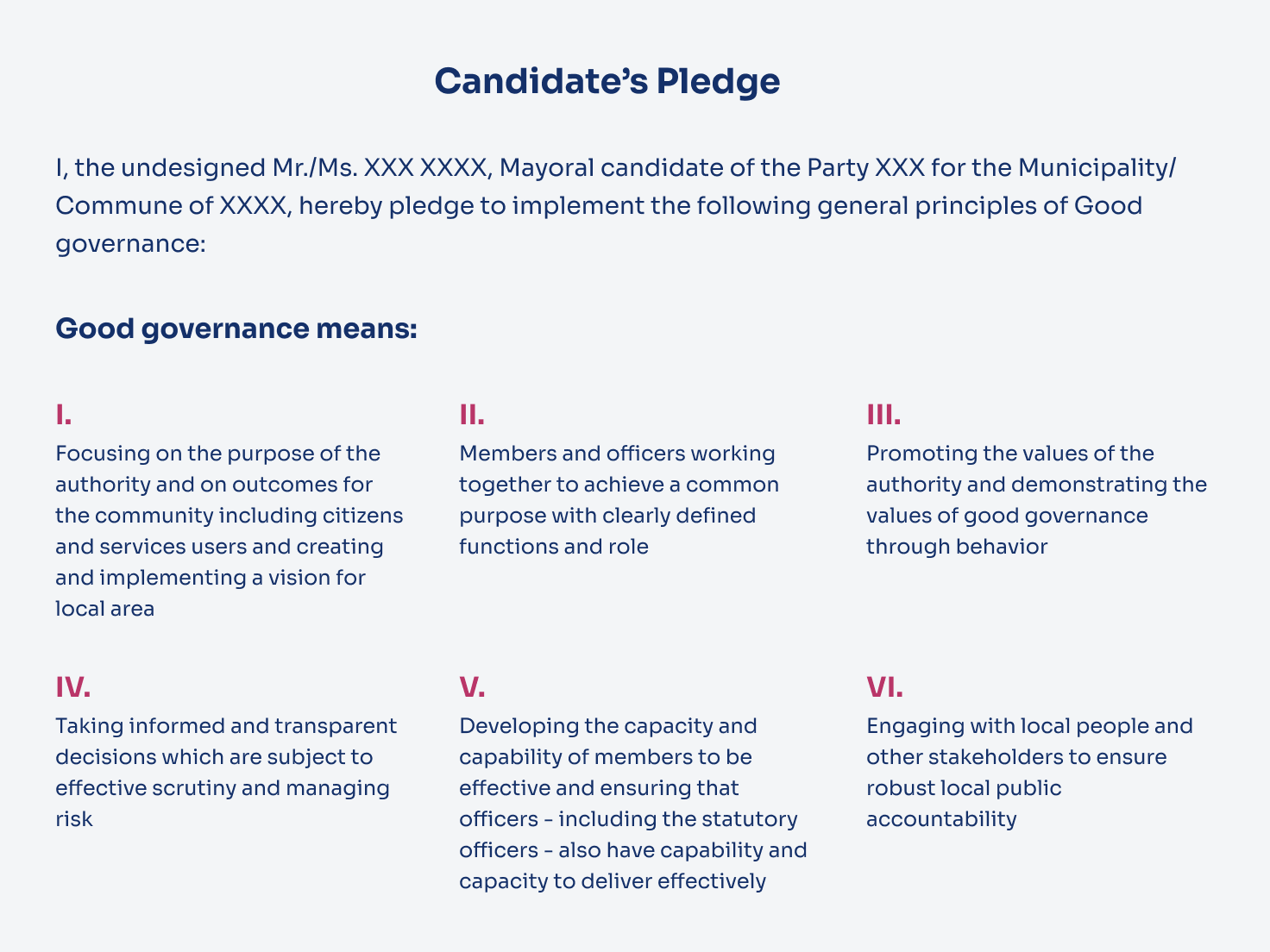A pledge drive is a pre-election initiative where citizen groups ask candidates to publicly commit to upholding a set of principles or to take specific actions if they are elected. The candidate’s commitment is made by signing the pledge and, thus, campaign pledges often hold more weight than campaign promises.
Purpose: Typically, groups use this tactic to get candidates to commit to good governance principles once in office, such as measures to reduce corruption, increase transparency and improve government responsiveness. However, pledge drives can also be used by issue-based organizations to get candidates to commit to a specific policy solution that the group deems important. In the post-election period, groups can use pledge drives to monitor elected officials’ behavior and accountability to their campaign pledges.
Considerations: On their own, pledge drives are not monitoring initiatives, but they do set the stage for post-election monitoring during which citizens can hold newly elected officials accountable for the pledges they signed. Because pledge drives tend to be highly publicized and officials often feel the pressure of the spotlight, it can be a good tactic for holding elected leaders accountable at the national level.
Pre-election
In order to be meaningful, pledge drives require candidate, political party, media and citizen buy-in. As such, these drives are often conducted by national-level CSOs or a coalition of CSOs with a wide geographical reach, strong connections with political parties, and a high capacity for managing media relations.
To be fair and balanced, all candidates or parties contesting the elections should be presented with the opportunity to sign the pledge. In some instances, only a few candidates may sign the pledge. However, even those candidates who refuse or do not respond to a group’s pledge campaign send a message to voters. Sometimes none of the signatories to the pledge are elected, and thus there is very little to track after the elections. In these cases, the pledge drive serves more as a voter guide by signaling to voters which candidates were ready to act on the issues. In any scenario, pledge drives have the power to encourage competition among candidates in terms of their readiness to abide by democratic principles and adopt good policies to meet citizen needs.
Groups have created pledge campaigns by:
- Developing a pledge document outlining the desired post-election behavior. This may be a pledge to adhere to good governance or anti-corruption standards, or it may be a pledge to agree to solving a specific priority issue if elected;
- Meeting with candidates to explain the pledge drive and encourage them to sign on;
- Organizing a highly publicized (preferably televised) event where key candidates sign the pledge;
- Developing and disseminating posters, buttons and stickers with the pledge drive logo;
- Continuously meeting with political party representatives and other candidates to explain the pledge drive, gain support for the campaign, and encourage candidates to sign the pledge; and
- Continuing to publicize the pledge drive through TV, radio interviews and press conferences.

Post-election
Follow-through on the pledge drive must be tracked in the post-election period for the monitoring initiative to be effective. Groups can do this by:
- Developing a monitoring form;
- Identifying communities where newly elected officials signed the pledge;
- Establishing a monitoring group of 10-15 active citizens in each of the identified communities;
- Meeting with local government officials to explain the project and inform them they will be monitored;
- Training the monitoring groups on how to evaluate local government officials and complete the monitoring form;
- Holding pre-assessment meetings with the local government officials and monitoring groups so that the officials can talk about their accomplishments and ongoing efforts;
- Providing any necessary support as the local monitoring groups observe and analyze local officials’ performances;
- Collecting the local monitoring groups’ findings and regularly compiling the information into performance report cards;
- Holding regular meetings with the monitored local officials to share the performance report cards, discuss the results and provide feedback; and
- Holding an event to recognize the achievements of the highest-scoring officials.
In Albania, during the post-election phase of the “Good Governance Monitoring Campaign,” citizen groups participated in city council and municipal meetings to determine the extent to which newly elected representatives were upholding their pledges. ACAC used a monitoring form to engage citizen groups and communes in monitoring and assessing the performance of the mayors and local representatives who had signed the good governance pledge in the pre-election period. ACAC concluded the initiative with a roundtable honoring the top mayors who scored highest on their good governance report cards.
Recommendations for Program Implementers
- Identify reformers within political parties and involve them to the extent possible in campaign-related monitoring initiatives.
- Because the election period is limited, there is generally not a lot of time for in-depth discussions on a wide range of issues. Citizens and CSOs should systematically prioritize the issues they want candidates to address.
- Consider that a large part of campaign monitoring is to make candidates and parties more concrete in their promises and commitments and more realistic to context.
- Civic groups can initiate small-scale campaign monitoring by focusing on only one issue of interest and one or two regional elections. Campaign monitoring does not have to cover all the issues or the whole country.
- Campaign monitoring will most likely become useful for any other type of political process monitoring and advocacy campaigns, thus it should be considered by all civic groups.